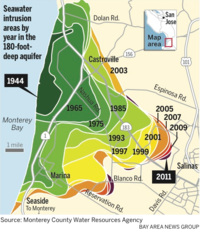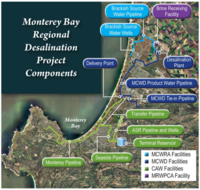Regional Water Project
Contents
Summary
The Regional Water Project (RWP) or Regional Desalinaton Project is a now defunct desalination project approved on April 5, 2010 by the Marina Coast Water District (MCWD) .[1] The $404,500,000 project represented a 3-way partnership between the MCWD, Monterey County Water Resources Agency (MCWRA), and the California American Water Company (CalAm).[2] The project sought to replace existing Monterey Peninsula water supplies that were restricted by previous legal decisions, as well as provide a new water supply to allow for the redevelopment of the former Fort Ord. The RWP intended to integrate several water supply sources to meet both existing and future water demands. The project was slated to be implemented in phases and included vertical seawater intake wells, a desalination plant, product water storage and conveyance facilities, and expansions to the existing Seaside Groundwater Basin. In addition, the RWP was intended to develop water supplies from the Salinas River through the expansion of the Salinas River Diversion Facility (SRDF) and Regional Treatment Plant (RTP), the Castroville Seawater Intrusion Project (CSIP) and the Seaside Groundwater Basin Replenishment Project [3]. On January 17, 2012 CalAm withdrew from the project amidst allegations of conflicts of interest.[4] The Monterey Peninsula Water Supply Project (MPWSP) is a desalination project that was created to replace the RWP.
Background
CalAm utilizes the Carmel River Groundwater Basin as a source of potable water for customers on the Monterey Peninsula. Unlike other areas of California, the Monterey Peninsula does not import water and is therefore dependent on the Carmel River [2]. For years, the company had withdrawn more than the amount allotted by the state, causing damage to the flora and fauna in the area. The State Water Resources Control Board (SWRCB) has issued two cease and desist orders (CDO), first in 1995 and again in 2009 for CalAm's continued overdrafting of the river. [5] [6] In addition, the ground water supply from Salinas is threatened by seawater intrusion in the 180-foot aquifer. As a result, extraction from this basin is limited.[7] The restrictions on water extraction limited the available water for CalAm customers and was cited as the impetus of RWP [2].
Project Objective
The overarching objectives of RWP included:
- To meet the requirements of SWRCB Order 95-10;
- Create a drought-proof water supply of 10,500 Acre-feet per year (AFY);
- Reclaim seawater-intruded water in the 180-Foot Aquifer of the Salinas Valley Groundwater Basin (SVGB);
- Improve the hydrologic balance of the SVGB;
- Protect listed species below the San Clemente Dam;
- Minimize adverse effects of an uncertain water supply;[2]
Proposed Location and Layout
Location of service areas
The location for the the project was defined by CalAm service areas of Carmel-by-the-Sea, Del Rey Oaks, Monterey, Pacific Grove, Sand City, and Seaside, and the unincorporated areas of Pebble Beach, Carmel Valley, and Monterey; the Highway 1 Corridor; the Marina Coast Water District service area including Fort Ord, Marina; Salinas, and Northern Monterey County rural and urban areas, including Castroville, Prunedale, Moss Landing, and Pajaro.[8]
Location and Layout of Project
The proposed intake mechanisms included five vertical seawater intake wells located on coastal dunes south of the Salinas River and north of Reservation Road. The water taken in by wells would have then be transported in a pipeline to a 10-mgd desalination plant on Armstrong Ranch in North Marina. A second, smaller desalination facility was proposed in Sand City.[8]
Proposed Implementation
The RWP was slated to be developed in two phases to ultimately provide up to 25,600 afy to CalAm customers in Carmel, Del Rey Oaks, Monterey, Pacific Grove, Sand City, and Seaside, and the unincorporated areas of Pebble Beach, Carmel Valley, Monterey-Salinas Highway Corridor, and the airport district; MCWD customers in former Fort Ord and Marina; and Northern Monterey County rural and urban areas, including Castroville, Prunedale, Granite Ridge, Moss Landing, and Pajaro.[8]
Phase 1
Phase 1 would meet the immediate needs of Monterey Peninsula, the former Fort Ord, and Marina with 15,200 afy. The first phase would take place over the course of three years and would be centered around the following:
- Water conservation
- Construction of Sand City Desalination Facility
- Construction of the Regional Urban Water Augmentation Project (RUWAP), a recycled water distribution system to provide 1,000 afy from the Salinas Valley Reclamation Plant (SVRP) to Fort Ord
- Construction of Seaside Basin Aquifer Storage and Recovery (Seaside ASR)
- Construction of Regional Desalination Facility, including the completion of conveyance and several storage facilities[8]
Phase 2
Phase 2 was intended to supply an additional 10,400 afy of water to meet the demands of the entire service region. The specific components and contributions to the supply of water were not fully understood or outlined at the time of the final EIR and were slated to be determined in the future. CalAm stated "the Phase 2 Project components may require further evaluation of costeffectiveness, technical, and implementation issues, as well as further environmental review".[9] The components for Phase 2 were roughly outlined as:
- Pacific Grove Stormwater Project
- Surface Water Delivery to Urban Users, including the utilization of diverted and treated Salinas River and surface water
- SRDF Expansion
- CSIP Expansion
- Regional Desalination Facility Expansion
- Seaside Groundwater Basin Replenishment Project
- Salinas Basin Groundwater for North Monterey County[9]
Project Failure and Legal Actions
Inherent Problems
The California Public Utilities Commission (CPUC) reviews all applications for private and public utilities. The RWP was submitted for review by the CPUC, which consists of semi-judicial hearings with public comment. The RWP was approved despite concerns from members of the community. One problem stemmed from the use of diverted water from the Salinas and the Salinas Valley Groundwater Basin (SVGB). Legislation that established the MCWRA prohibits water export from the SVGB. The plan for the RWP would violate this legislation and potentially jeopardize availability of Salinas Valley agricultural water.[10] The plans for drawing from the Salinas River were moved from phase 1 of the Draft EIR to phase 2 of the Final EIR, putting off the use of river water but not eliminating the option. [9] Allegations of conflict of interest violations against the MCWD Director Steve Collins derailed the project in 2012.[4]
Legal Action
Steve Collins, the former director of MCWRA, was charged with a conflict of interest in the RWP for working with RMC Water and Environment as a paid consultant while holding public office.[11] [12] Suspicions of criminal activity first arose when Collins recused himself from voting on a $28 million contract with a consulting firm, RMC Water and Environment, in February 2011. The recusal indicated Collins' financial conflict of interest and illicit financial involvement in the RCM contract for the RWP.[11] On April 12, 2011, an investigation was launched by Monterey County Counselmember Charles McKee to explore allegations against Collins and his involvement with RMC while serving as a member of the MCWRA Board of Directors for 16 years. [13] In late 2011 Collins was charged with 42 felony and misdemeanor counts, including the felony violation of Government Code Section 1090 And the Political Reform Act.[11] In May 2014 Collins was sentenced to nine months in jail and probation. It was revealed that Collins was paid more than $160,000 by MCWD as a consultant for RMC while maintaining his position as director of MCWRA.[14] Government Code Section 1090 criminalizes conflict of interest:"Members of the Legislature, state, county, district, judicial district, and city officers or employees shall not be financially interested in any contract made by them in their official capacity, or by any body or board of which they are members. Nor shall state, county, district, judicial district, and city officers or employees be purchasers at any sale or vendors at any purchase made by them in their official capacity" [15]Similarly, the Political Reform Act "[p]rohibits public officials from participating in governmental decisions affecting their "financial interests" and requires certain public officials to disclose certain assets and income" [16] In early 2012, CalAm withdrew its support from the RWP, effectively ending the project, as a result of the investigation into Collins, financial issues, and legal challenges to the project's EIR [4].
References
- ↑ MCWD Resolutions
- ↑ 2.0 2.1 2.2 2.3 Regional Desalination Project
- ↑ RWP description in footnote 3
- ↑ 4.0 4.1 4.2 CalAm Withdraws Support
- ↑ SWRCB WR 95-10
- ↑ SWRCB WR 2009-0060
- ↑ RWP report to SWCB
- ↑ 8.0 8.1 8.2 8.3 Draft EIR
- ↑ 9.0 9.1 9.2 Final EIR
- ↑ Land Watch
- ↑ 11.0 11.1 11.2 Collins Pleads No Contest
- ↑ Collins Conflict of Interest
- ↑ Report of Collins Conflict of Interest
- ↑ Collins Sentenced
- ↑ Government Code 1090
- ↑ Political Reform Act
Links
- Desalination
- Marina Coast Water District
- Salinas River Diversion Facility (SRDF)
- Fort Ord
- Seaside Groundwater Basin
- Monterey County Water Resources Agency
- California American Water Company
- Monterey Peninsula
- Salinas River
- Seaside Groundwater Basin Replenishment Project
- Castroville Seawater Intrusion Project (CSIP)
- Monterey Peninsula Water Supply Project (MPWSP)
- CalAm utilizes the Carmel River Groundwater Basin
- Salinas Valley Seawater Intrusion
- State Water Resources Control Board
- Salinas Valley Groundwater Basin
- San Clemente Dam
- Regional Urban Water Augmentation Project (RUWAP)
- California Public Utilities Commission (CPUC)
Disclaimer
This page may contain student work completed as part of assigned coursework. It may not be accurate. It does not necessary reflect the opinion or policy of CSUMB, its staff, or students.

